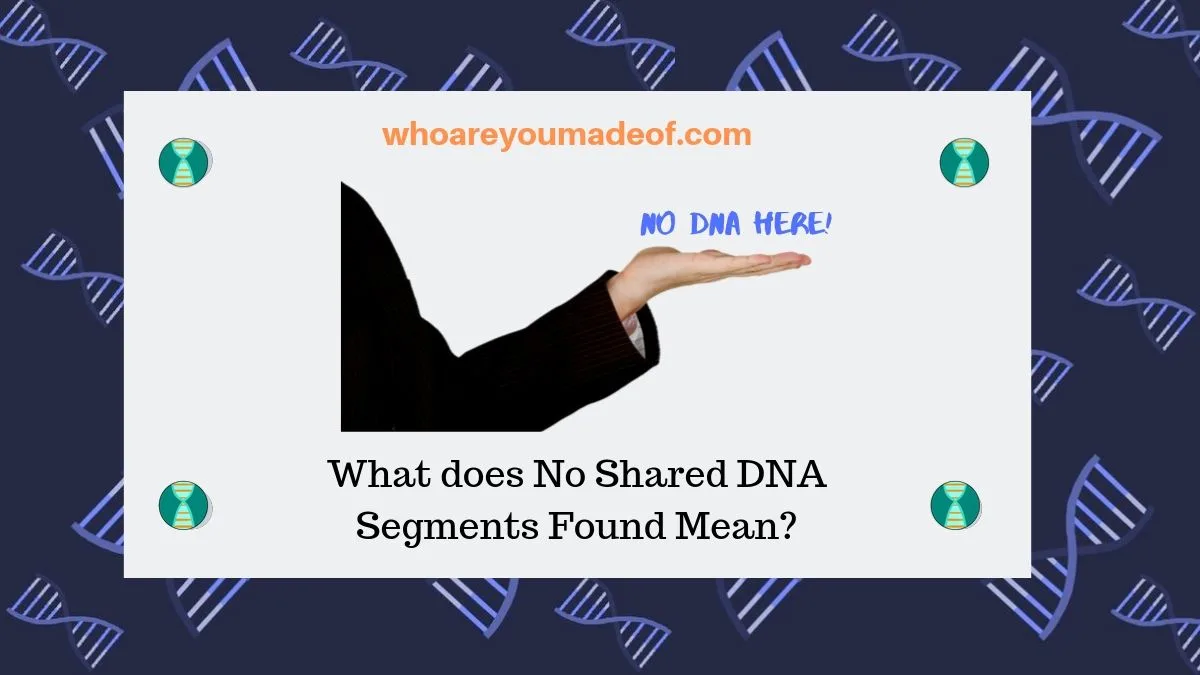Did you read that no shared DNA segments were found when you compared your DNA with a relative on a chromosome browser? Do you want to know what this really means?
In this post, learn the answer to this question, plus:
- What it means to share no DNA with a known relative
- Whether you should expect to share DNA segments with someone who you think might be a distant cousin
It can be very disappointing to find no shared DNA segments when comparing your DNA to someone with whom you expected to share DNA. Whether or not the “no shared DNA segments” message means that you have discovered a mistake in family tree research, or even a family secret, depends on how closely related you believe yourself to be to your relative.

This article generally refers to the chromosome browser on Gedmatch, which you can access via the One-to-One comparison tool. If you used a chromosome browser on a different site and found no shared DNA with a relative, the information here is applicable.
What does it mean when no shared DNA segments are found?
When no shared DNA segments are found, it means that there is no shared DNA found at the default segment size settings. Many times, this means that you are not genealogically related to the person whose DNA you compared to yours.
Even so, we don’t share DNA with all of our relatives. If you are surprised that you don’t share DNA with someone, definitely keep reading to learn more and to find out steps you can take to find an explanation.
Some chromosome browsers allow you to adjust the default segment size in order to look for smaller segments, or only view segments that are larger than a desired size. We understand that very small segments are very likely to be false segments, so the Gedmatch One-to-One tool will only display segments that are larger than 7 cm (centimorgans) in size.
If you desire, you can adjust the segment threshold down a bit to see if you find a shared segment at a slightly lower threshold. This is most useful with known distant relatives, and it is important to understand that we can still share false segments with people who are really related to us.
No shared DNA segments found with a known relative
If you compared your DNA with that of a known relative and found no shared DNA segments, you might be worried. Before you jump to conclusions, it’s important to understand that sometimes it’s completely normal to share no DNA with someone who isn’t closely related.
Of course, we should always share DNA with our parents, siblings, aunts, uncles, grandparents, first cousins, and other people who are related to us more closely than at a second cousin once-removed relationship distance.
Once we start comparing our DNA to relatives like second or third cousins, especially half-second or third cousins, we will start to find the occasional relative that doesn’t share DNA with us.
In fact, we don’t share DNA with about 10% of our third cousins.
If the person that you believe is related to you should be a second cousin or close and you don’t share DNA, you should consider comparing their DNA with other family members. If possible, have additional family members test, especially those who are more recent descendants of the common ancestor.
For example, if you have a half-second cousin once-removed who doesn’t share DNA with you, you should have your parent test, if possible. This is because your parent is more recently descended from the great-grandparent you share with your second cousin once-removed.
Alternatively, you could compare your DNA with other people who are descended from the great-grandparent. For example, if you have other second and third cousins from those ancestors, you can examine your shared DNA to see if it falls within expected levels.
No shared DNA segments found with a distant cousin
As you might expect, it is very common to share no DNA with distant cousins. If you don’t share DNA with a distant cousin, it simply means that you and your relative didn’t inherit identical pieces of DNA from your shared ancestor.
We will share DNA with only 50% of our fourth cousins. As we move further out in our family tree, the odds of shared genetic material are reduced even more dramatically.
For example, the chances of sharing DNA with someone with whom we share great-great-great-great-great-grandparents (i.e. 6th cousins) are less than 10%. If we do share DNA with a 6th cousin, it won’t be very much.
When it comes to distant cousins to whom you are fairly certain you are related, it can be fun to reduce the segment threshold on the chromosome browser to 5 cMs just to see if a smaller identical segment is hiding there somewhere in your chromosomes. If you are interested in tracing a smaller segment shared with a family-tree-verified distant relation, you might want to learn more about:
- phased matching on Gedmatch
- chromosome mapping (using DNA Painter)
Conclusion
I hope that this post has helped you understand more about what it means to see “no shared DNA segments found” on your Gedmatch One-to-One results or a chromosome browser.
If you have any questions about something that you read in this post, or if you would like to post a specific question about sharing no DNA with a particular relative, I would love to hear from you in the discussion below.
Thanks for stopping by today!

